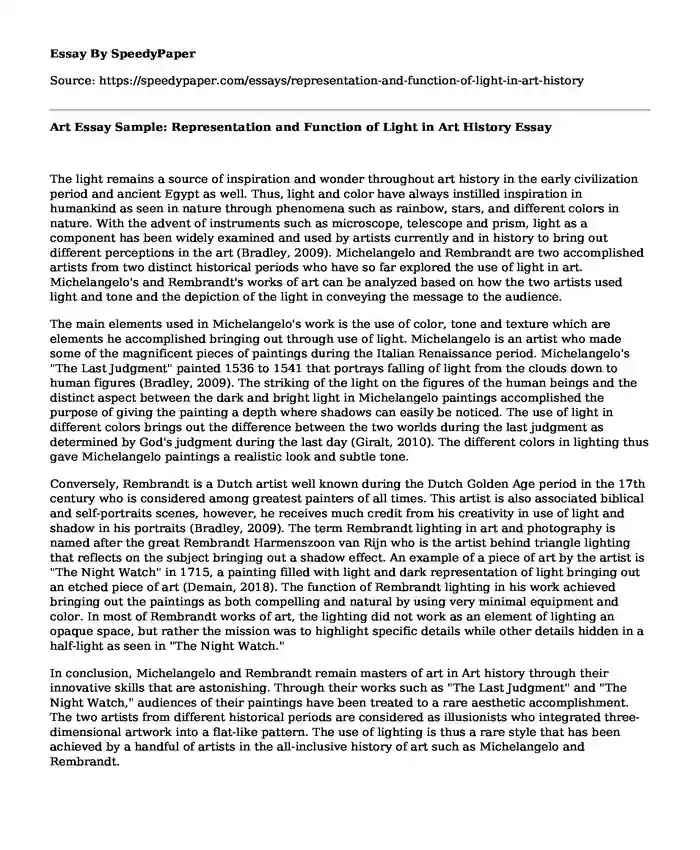The light remains a source of inspiration and wonder throughout art history in the early civilization period and ancient Egypt as well. Thus, light and color have always instilled inspiration in humankind as seen in nature through phenomena such as rainbow, stars, and different colors in nature. With the advent of instruments such as microscope, telescope and prism, light as a component has been widely examined and used by artists currently and in history to bring out different perceptions in the art (Bradley, 2009). Michelangelo and Rembrandt are two accomplished artists from two distinct historical periods who have so far explored the use of light in art. Michelangelo's and Rembrandt's works of art can be analyzed based on how the two artists used light and tone and the depiction of the light in conveying the message to the audience.
The main elements used in Michelangelo's work is the use of color, tone and texture which are elements he accomplished bringing out through use of light. Michelangelo is an artist who made some of the magnificent pieces of paintings during the Italian Renaissance period. Michelangelo's "The Last Judgment" painted 1536 to 1541 that portrays falling of light from the clouds down to human figures (Bradley, 2009). The striking of the light on the figures of the human beings and the distinct aspect between the dark and bright light in Michelangelo paintings accomplished the purpose of giving the painting a depth where shadows can easily be noticed. The use of light in different colors brings out the difference between the two worlds during the last judgment as determined by God's judgment during the last day (Giralt, 2010). The different colors in lighting thus gave Michelangelo paintings a realistic look and subtle tone.
Conversely, Rembrandt is a Dutch artist well known during the Dutch Golden Age period in the 17th century who is considered among greatest painters of all times. This artist is also associated biblical and self-portraits scenes, however, he receives much credit from his creativity in use of light and shadow in his portraits (Bradley, 2009). The term Rembrandt lighting in art and photography is named after the great Rembrandt Harmenszoon van Rijn who is the artist behind triangle lighting that reflects on the subject bringing out a shadow effect. An example of a piece of art by the artist is "The Night Watch" in 1715, a painting filled with light and dark representation of light bringing out an etched piece of art (Demain, 2018). The function of Rembrandt lighting in his work achieved bringing out the paintings as both compelling and natural by using very minimal equipment and color. In most of Rembrandt works of art, the lighting did not work as an element of lighting an opaque space, but rather the mission was to highlight specific details while other details hidden in a half-light as seen in "The Night Watch."
In conclusion, Michelangelo and Rembrandt remain masters of art in Art history through their innovative skills that are astonishing. Through their works such as "The Last Judgment" and "The Night Watch," audiences of their paintings have been treated to a rare aesthetic accomplishment. The two artists from different historical periods are considered as illusionists who integrated three-dimensional artwork into a flat-like pattern. The use of lighting is thus a rare style that has been achieved by a handful of artists in the all-inclusive history of art such as Michelangelo and Rembrandt.
References
Bradley, M. (2009). Colour and meaning in ancient Rome (p. xiii267). Cambridge: Cambridge University Press.
Demain, C. (2018). Rembrandt Lighting in Photography. Retrieved from https://www.picturecorrect.com/tips/rembrandt-lighting-in-photography/
Giralt, G. F. (2010). Realism and realistic representation in the digital age. Journal of film and video, 62(3), 3-16.
Cite this page
Art Essay Sample: Representation and Function of Light in Art History. (2022, Jun 14). Retrieved from https://speedypaper.com/essays/representation-and-function-of-light-in-art-history
Request Removal
If you are the original author of this essay and no longer wish to have it published on the SpeedyPaper website, please click below to request its removal:
- Career Strategy Essay Sample
- Government Vision Essay Sample
- Essay Sample on The Adventures of Robin Hood Movie
- Empowerment of Older People - Free Essay on Gerontology
- Essay Example: Lancet Article on the Gonorrhea Issue
- Essay Example on Islam and Muslims in the West
- Essay Example about Interpersonal Communication and Social Media
Popular categories





